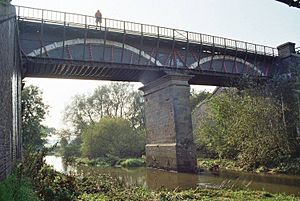Cosgrove aqueduct facts for kids
Quick facts for kids Cosgrove Aqueduct |
|
|---|---|

The Cosgrove aqueduct
|
|
| Coordinates | 52°04′07″N 0°50′01″W / 52.0687°N 0.8336°W |
| OS grid reference | |
| Carries | Grand Union Canal |
| Crosses | River Great Ouse |
| Locale | Cosgrove |
| Maintained by | British Waterways |
| Characteristics | |
| Trough construction | cast iron |
| Pier construction | Brick |
| Total length | 101 feet (31 m) |
| Width | 15 feet (4.6 m) |
| Height | 60 feet (18 m) |
| Water depth | 6 feet 6 inches (1.98 m) |
| Traversable? | 15 ft, but in a Narrowboats-only canal section |
| Towpaths | NE Side |
| Number of spans | Two |
| Piers in water | One |
| History | |
| Designer | Benjamin Bevan |
| Opened | 26 August 1805 |
| Rebuilt | January 1811 |
The Cosgrove Aqueduct is a special kind of bridge. It's a navigable aqueduct, which means it carries a canal over a river. This one carries the Grand Union Canal over the River Great Ouse. You can find it where Buckinghamshire and Northamptonshire meet, near Milton Keynes in England.
The aqueduct you see today was built in 1811. It's made of cast iron and replaced an older brick structure that had fallen apart. When it was first built, people called it the "Iron Trunk" because of its strong metal design.
This amazing structure has two sections made of cast iron. These sections hold the water for the canal. There's a single stone support in the middle of the river. The ends of the aqueduct were originally stone, but they've been covered with brick more recently. The canal trough is about 15 feet (4.6 meters) wide and 6 feet 6 inches (2 meters) deep. The whole aqueduct is 101 feet (31 meters) long. The canal water flows about 40 feet (12 meters) above the river below. Huge earth ramps, about 36 feet (11 meters) high, lead up to the aqueduct. These ramps stretch for about half a mile (800 meters) across the valley.
Contents
Why Was the Aqueduct Built?
The Grand Junction Canal (which is now part of the Grand Union Canal) needed a way to cross the River Great Ouse. This river was the lowest point between two high areas along the canal's route.
At first, a series of locks were used. Locks are like water elevators for boats. Boats would go down four locks on one side, cross the river at ground level, and then go up five locks on the other side. This system started working in 1800.
However, the canal company's engineer, William Jessop, had a better idea. He designed a brick aqueduct with three arches. This would let the canal cross the river at a higher level. This was important because it would save water and prevent delays from boats having to use so many locks.
The First Aqueduct's Problems
William Jessop's brick aqueduct opened on August 26, 1805. But soon after, problems began. In January 1806, a part of the canal's earth bank collapsed. This was fixed, but then the aqueduct itself fell apart in February 1808. This meant the canal was completely cut off!
Even though Jessop is sometimes blamed, the collapse actually led to a big legal fight. The canal company sued the original builder. The court decided that the builder had to pay the Grand Junction Company. This money covered the lost business while the canal was closed and the cost of building a new aqueduct.
Building the Second Aqueduct
While a new aqueduct was being planned, the old lock system was used again as a temporary fix. Benjamin Bevan, another engineer working for the canal company, designed the replacement.
By this time, aqueducts made of cast iron had proven to be very strong and reliable. Famous engineer Thomas Telford had built successful iron aqueducts, like the Pontcysyllte Aqueduct. Bevan decided to use this strong cast iron system for the Cosgrove Aqueduct.
The canal at Cosgrove was a "wide canal," meaning it was wider than some of the "narrowboat" canals in the north. This meant the iron sections had to be much bigger and stronger than other iron aqueducts.
The large cast iron pieces were made at the Ketley foundry in Coalbrookdale. This company had also worked with Telford on other aqueducts. The iron parts were brought to Cosgrove by the canal itself, which was very convenient. Workers then put them together on site. The new, strong iron aqueduct was finished in January 1811.
How the Aqueduct Was Built Strong
To make sure the new aqueduct could hold the weight of a wide canal, Benjamin Bevan designed the bottom sections to be arched. This arch shape made them much stronger. Also, there are special arch ribs built into the sides of the trough. These ribs add even more strength.
The towpath, which is the path alongside the canal for people or horses to pull boats, sticks out from one side of the aqueduct. It's supported by diagonal metal bars, similar to how the towpath is built at Froncysyllte.
You can also find small tunnels called "cattle creeps" in the earth banks on either side of the aqueduct. These are openings that allow farm animals, and sometimes people, to pass from one field to another under the canal.

